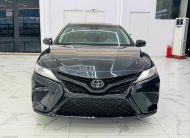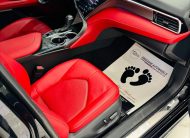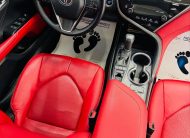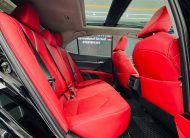- Overview
- Location
The Toyota Camry is such a well-known commodity that each new generation brings with it the expectation of, well, more Camry-ness. More of the stubbornly consistent formula that has made it thoroughly innocuous and also the best-selling car (pickups excluded) in the United States for 15 years straight: a roomy cabin, a floaty ride, solid fuel economy, reliability that would make the Maytag repairman envious, and driving character so bland it gives vanilla a bad name.
But with this all-new eighth-generation model that is hitting the market now, Camry-ness takes a significant turn. Credit Toyota CEO Akio Toyoda, who has decreed that all of the company’s new products be infused with a modicum of stylistic passion and driving verve—far be it from us to argue—so the Camry has received a major overhaul, including a new platform, more aggressive styling, and vastly improved driving dynamics.
What hasn’t changed is that there are still two branches on the Camry family tree: the sporty-ish models (SE, XSE) and the luxury-oriented branch represented by our top-level XLE hybrid test car. The new XLE is traditional Camry ratcheted way up, to much higher levels of capability and refinement.
Inside and out, the new XLE gives off a premium vibe foreign to Camrys of yore. Built on Toyota’s New Global Architecture (TNGA), the 2018 Camry rides on a 2.0-inch-longer wheelbase and is about an inch and a half longer, an inch lower, and three-quarters of an inch wider. The resulting proportions and elegantly sloping roofline give it a more substantial, upscale look. Brightwork is delicately applied. But for the XLE’s unfortunate grimace of a front end, it almost could be mistaken for an entry-luxury sedan.
That impression is reinforced when you drop into the driver’s seat. Passenger space is virtually unchanged and glass area remains plentiful, so the cabin once again feels roomy, airy, and open. The interior materials, finishes, and design details are surprisingly rich. Our dark-brown XLE’s standard furnishings included quilted leather seats in a subtle, two-tone tan that reminded us of the chairs in more expensive sedans. Soft surfaces abound, and hard plastic trim pieces are well disguised.
Designer touches unexpected in a mass-market sedan are scattered about the cabin. For instance, the delicate interior door handles are the tips of the satin-aluminum spears adorning the door-trim panels. The eject button for the CD player in the top Entune 3.0 infotainment system is integrated elegantly into a thin band of bright trim so it all but disappears. A strip of faux wood flanking the sweeping center stack refracts light in a way that makes it shimmer intriguingly.
The pleasant surprises extend to the way the XLE drives. It has clearly benefitted from the switch to the TNGA underpinnings—the body’s torsional stiffness has increased by 30 percent, and the old car’s rear struts are replaced with a more sophisticated multilink setup. No longer does the Camry bob disconnectedly over ruffled pavement as if someone unbolted the shocks and threw them overboard. It now lopes across the larger swells and damps out bumps swiftly and smoothly, with no aftershake. Tar strips and other road blemishes are muffled thumps heard more than felt.
The steering, light at low speeds, actually feels connected to something now, with surprising heft at highway velocities, a strong sense of center, and crisp response when you swing the wheel into a bend. The XLE still is not a car that you hurl at apexes—skidpad grip is a reasonable 0.84 g, although the stability control jumps in early and often—but it’s in the zone now, a thoroughly competent sedan that goes about its business with an air of composure.
The Camry lineup offers three engine choices, all of them new for 2018: a base 203-hp 2.5-liter inline-four (206 hp in the XSE); a 301-hp 3.5-liter V-6; and the 208-hp (total system power) hybrid powering our test car. We found the hybrid powertrain a good fit with the XLE’s relaxed driving persona. Acceleration is seamless, and off-the-line throttle response in the Normal and Sport modes is far livelier than the hybrid’s 7.9-second zero-to-60-mph time would suggest.
Request anything more than modest acceleration, though, and the hybrid’s CVT-like arrangement allows the engine to zing up to moderately high rpm and hang there—a behavior common to continuously variable automatic transmissions (CVTs) and to hybrid powertrains. While it’s not a terrible sound, we’d still rather there were less of it penetrating the otherwise quiet cabin. Not that Toyota didn’t try: It added a manual mode that enables the driver to sift through six simulated gear steps with the console-mounted shifter, but it had little effect on either the noise emanating from underhood or the rate of forward progress.
Toyota has done better when dealing with the squishy brake-pedal feel and inconsistent response that plague many electrified cars’ regenerative braking systems. At any speed beyond about 5 mph, the XLE hybrid’s brakes feel virtually normal; the pedal is firm at the top of its travel and easy to modulate. The system does have one remaining behavioral flaw in that, at walking speeds, the brakes sometimes can be annoyingly grabby.
Those are small negatives relative to the satisfaction of making big numbers roll up on the readout in the gauge cluster and on the center stack’s hybrid-system screen. To do this, you’ll want to drive in Eco mode, which deadens throttle response and keeps engine rpm as low as possible. You’ll notice almost no regenerative braking when you lift off the throttle (coasting saves energy) and some electric-only acceleration up to 10 or 15 mph if you’re light on the accelerator. (EV mode didn’t significantly increase the time the car spent driving solely on electricity.)





























